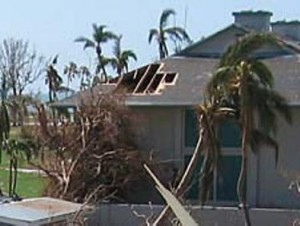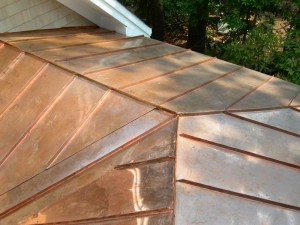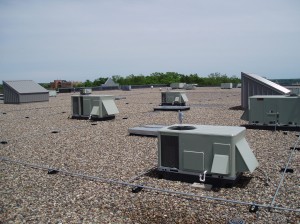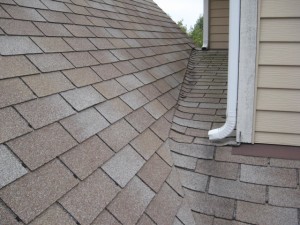Archive for August, 2011
Sealed Roofs Hold Up Better in Hurricanes
Research shows roof-deck seams that are sealed can protect from rain and high wind damage. The engineers at Insurance Institute for Business and Home Safety conducted experiments about water penetration from gusty winds and rain such as with hurricanes.
For residential roofs the rain from storms can breach the openings in the roof deck seams causing thousands of dollars in damage. To reduce the damage cover the seams on the outside of your roof with a modified bitumen tape and from the inside with closed cell foam spray adhesive.
At their research center in South Carolina, IBHS built a 1,300 square foot single story duplex to perform extensive tests. They wanted to determine the extent of water damage that occurs during hurricanes and other wind driven rain. They placed the building into a 21,000 square foot test chamber and subjected it to high speed, multi directional winds and simulated rain at 8” per hour.
With the exception of using the modified bitumen tape to seal between the sheathing joints and gaps on one side of the roof, both sides of the duplex were identical, complete with furniture, light fixtures and ceiling fans. The tests clearly showed that water damage was substantially less in the roof that has had the deck seams sealed. The unsealed side had water streaming off the light fixtures and ceiling fans and the ceiling collapsed from the attic being saturated with water. On the sealed side much less water entered the duplex.
According to an adjuster, the damage from the unsealed side was three times the amount of damage to the sealed side. Sealing your roof can greatly reduce the chances of a wide-spread loss due to water damage. Sealing an average sized roof with modified bitumen tape costs approximately $500. You might want to ask a roofer or contractor is this is a good option for you.
Hurricane Irene Damage May Lead To More Roof Scams
 Many Americans spent the weekend trying to evacuate their homes and protect their belongings, only to return to find the destruction Irene left in its path. Many homeowners were flooded out of their homes and had significant roof damage.
Many Americans spent the weekend trying to evacuate their homes and protect their belongings, only to return to find the destruction Irene left in its path. Many homeowners were flooded out of their homes and had significant roof damage.
Unfortunately, some homeowners may not have had roof insurance, leaving them with the repair bill. As people plan to rebuild their lives and repair their homes, some fraudulent repair companies will be prowling for victims of their next roof scam.
Aiding The Victims
Hurricane Irene left an estimated $13 billion in damage in its wake. With an already strapped federal budget, many are worried relief efforts will be reminiscent of Katrina; where homeowners waited years to receive relief funds. Homeowner’s insurance companies along the East Coast are bracing for an influx of claims and will be working overtime to ensure any money that is paid goes towards legitimate repairs.
Although there are plenty of legitimate roof repair companies that may advertise in a neighborhood after a storm, not all companies are the same. There are a few ways to spot non-reputable companies and ensure you get the best roof repair:
- Beware of initial contacts via door-to-door salespersons
- Always ask for a copy of the roof contractor’s license and registration with the county.
- Ignore doorknob hangers suggesting you may have roof damage
- Instead obtain several quotes from multiple companies.
- Be wary of a promise to cover the cost of an insurance policy deductible
- This is a sign of fraudulent bidding on repair costs.
- Be wary of an offer to help file your insurance claim
- You should be directly managing the claim with your insurance.
It is also important to remember that if you do sign a contract with a home repair company, by law you have three days to opt out of it.
History of Roofs
As long as man has been around there have been a need for shelter and protection from the elements. Throughout history roofs have been made from available resources. Cavemen covered their structures with sod roofs covered with earth and plants. These early shelters provided good insulation unfortunately they were not vermin or waterproof.
Research has shown the first known glazed clay roof tile was used in China 5,000 years ago. Greece and Babylon used flat earthenware roof tiles between 4,000 and 5,000 years ago. The Romans brought variations of the Greek clay tiles to England as early as 100 BC.
Around 735 AD thatched roofs were developed and used. Wood shingles were introduced 300 years later. In an effort to prevent spreading fires, the 12th century King John issued a law in London that citizens were to replace their thatch and reed roof coverings with clay tiles.
Industrial production of clay roofing tiles began in the 19th century. One hundred years later concrete roof tiles were first used, when first introduced in the early 1900’s the practice was to add a pigment to resemble clay roofing tiles.
In the early 1970’s Germany began developing and marketing the first green roof systems. Asphalt also became available in the 19th century. It quickly became a popular product due to the ability to mass produce it at a reasonable cost.
Most of the changes in roofing materials have developed in the last 200 years. Although people generally still use the most available materials for the region. Wood and metal are used in the southern part of North America, slate in the northeast, wood in the Midwest and tile in the southwestern part of North America.
Now we are seeing technological advances in glass, polymer and smog absorbing tiles. Who knows what will be common roof coverings in our near future. With a trend in energy savings we will undoubtedly see a emergence in earth friendly roof top materials.
Metal Roofs Targeted By Criminals
 We have all heard of criminals stealing metal pipe and wires from builds to sell for a few dollars, but metal theft is now moving into new territory. As the economy challenges us to make ends meet, a new style of crime is evolving. Metal roofs have become increasingly popular among metal thieves, robbing many unsuspecting home and business owners of their roof materials.
We have all heard of criminals stealing metal pipe and wires from builds to sell for a few dollars, but metal theft is now moving into new territory. As the economy challenges us to make ends meet, a new style of crime is evolving. Metal roofs have become increasingly popular among metal thieves, robbing many unsuspecting home and business owners of their roof materials.
In The News
Earlier this week, a church in England reported a significant portion of their metal roof was stolen for the third time. A Canadian business had its galvanized metal roof drip edges stolen by thieves, costing the business owner thousands of dollars in repairs and installation of an upgraded security system.
Thieves around the world are cashing in on the high demand for quality metal products. Since metal roofs are usually made from aluminum, steel or copper; thieves may be able to make significantly more when selling the stolen pieces to scrap yards.
Reliably Resourceful
Home and businesses owners favor metal roofs for two reasons (1) its durability and product life and (2) its aesthetic appeal. The cost of roof repair tends to be less with metal roofs as they, generally, rarely need repairing. Metal roofs offer a lighter weight alternative to traditional asphalt roof shingles and require less maintenance. They also fit nicely into the green roofing lifestyle, as much of metal roof products are made from recycled materials.
Replacing and Repairing Composition Shingles
It is good practice to check your roof yearly for cracked, curled, broken or missing composition shingles, also called asphalt shingles. Most roofing materials eventually wear out and need to be replaced. If you are comfortable walking around on your roof, you can usually make simple repairs yourself.
When repairing and replacing broken shingles, it is best to choose a warm day so the shingles are more pliable. You want them to lift and bend easily. If it is cold outside, you can use a propane torch to heat them up.
Install new shingles from the bottom up and place the top row under the ridge cap. Nail each 3 tab shingle with 4-8 nails on the printed line on the shingle. Leave a slight gap between shingles. If it is too hard to get underneath the shingle to put the nails, use 1 ¼” exterior screws.
Pull out any shingles in poor condition, remove nails and slip in replacement shingles. You don’t need to be perfect when replacing shingles, but try to match the shingle thickness to achieve a relatively even surface.
- Fill cracks with roofing cement.
- Put roofing cement under curled edges.
- For broken shingles, pry out the nails and pull out damaged shingles, cut notches in the new shingle to match the nail tears in old one. Slide new shingle in place and nail it down.
Tools needed:
- Sturdy ladder
- Hammer or hatchet
- Sharp utility knife
- Pointed trowel for applying cement
- Roofing nails 1” to 1 ½ “
- Composition shingles
- Roofing cement
If you are replacing shingles in valleys or around flashings, using the damaged piece as a pattern trim the shingles accordingly and use roofing cement to help hold them in place. Be sure not to obstruct the path of the valley so water does not build up.
Roof Rocket Is Going Local
 Roof repair and replacement can be expensive, which is why we have created a valuable resource for helping homeowners learn the important aspects of roofing. From information about the different types of roof materials to how you can help the environment with green roofing, we have the information you need.
Roof repair and replacement can be expensive, which is why we have created a valuable resource for helping homeowners learn the important aspects of roofing. From information about the different types of roof materials to how you can help the environment with green roofing, we have the information you need.
As homeowners, we know that finding the right information about how to maintain your roof to prevent costly repairs can be difficult. Roof Rocket is a leading source of knowledge and tools to educate homeowners and empower them to take control over the life of their roof.
Soaring To New Heights
As a resource for all things roof, we have expanded our services to offer more personalized attention to anyone looking for information about roofing.
Through Roof Rocket, you can find local roof contractors in your area, obtain a quote and even have a roofer contact you. We can you put in touch with a roofer anywhere in the U.S. and provide you with the tools necessary to find the best roof contractor.
Don’t waste another minute searching through endless advertisements in the phone book; find a high quality roof contractor in seconds through Roof Rocket. If you would rather have a professional roofer contact you, fill out our no-obligation evaluation form to get started today!
Warranties
Understanding warranty provisions and after sale issues on roofing products and materials could prove to be one of the most important decisions you can make when making roofing choices.
In 1975 congress enacted the Magnuson-Moss Warranty Act providing the rules and regulations to be issued by the Federal Trade Commission covering the use of warranties or guarantees on a broad range of consumer products.
The goal of this legislation and its subsequent FTC rules and regulations was to clear up consumer confusion and resolve consumer complaints about the products being purchased. Congress wanted to ensure that consumers could get complete information about warranty terms and conditions. To give consumers enough information so they could clearly read the duration and service options for the products.
Congress also intended to organize the rules and warranties to encourage manufacturers to provide more reliable products. Customers would be able to compare warranty coverage before committing to the product under the new act. Another aspect of the law was incentives for companies to settle complaints and disputes in a timely manner inexpensively and informally.
The law is basically to protect the consumer from deceptive warranty practices, to make the warranties easier to understand and enforceable. Replacing or repairing your roof is a large purchase amount, be prepared and know what your rights are in the event of problems with the product or services.
Saving For A New Roof
 We have all heard the saying “save for a rainy day”; well this saying is taking on new meaning for homeowners that may have a damaged roof in need of repair. Repairing or replacing a roof can be expensive and many homeowners simply are not prepared for the costs associated with roof replacement.
We have all heard the saying “save for a rainy day”; well this saying is taking on new meaning for homeowners that may have a damaged roof in need of repair. Repairing or replacing a roof can be expensive and many homeowners simply are not prepared for the costs associated with roof replacement.
What Can I Do?
Most people have some sort of emergency fund for unexpected costs and purchases. Getting a new roof does not have to be categorized as an unexpected cost. The bottom line is you should be saving money for roof repair and replacement.
As a homeowner, you should be budgeting about 1% of the value of your home for repairs each month. For example: if you have a $200,000 home, you should have at least $200 a month set aside for necessary home repairs.
If you haven’t already, you should begin saving money for a new roof immediately if your home has:
- A roof over 10 years old
- More than 2 layers of roof materials
- Visible damage to the roof
- Suspected (may or not be visible) roof damage
- A roof with multiple missing shingles, or shingles that are loose
- A roof that has a leak, or had a leak in the past
The truth is, most people don’t have this money set aside and haven’t even thought about the cost of roof repair or replacement until the time has come. Make a plan to set aside at least $25-$50 per month in a “roof repair” fund, you never know when you will need it.
Commercial Roof Challenges
 Keeping a well maintained roof is a challenge for any home or business owner. The weather, pests and debris can all threaten the integrity of a roof. Both residential and commercial roofs have their own challenges in terms of general maintenance and upkeep. However, commercial roofs pose unique problems that should be considered by any business owner.
Keeping a well maintained roof is a challenge for any home or business owner. The weather, pests and debris can all threaten the integrity of a roof. Both residential and commercial roofs have their own challenges in terms of general maintenance and upkeep. However, commercial roofs pose unique problems that should be considered by any business owner.
Roof Leaks
Commercial roofs are different from residential roofs in many ways, the main difference being the shape of the roof. Most commercial roofs are flat or carry less of a slope than residential roofs. Without a significant slope, water cannot drain properly and may accumulate on the roof. When water begins to pool on top of the roof, the constant moisture causes weak spots in the roof and results in water damage. Water damage can cause many costly repairs such as mold or mildew to the roof materials, and even risk having the roof collapse.
Traditionally, the metal flashing bridges the gap along a roof transition in between materials or between the roof and an additional structure. In many cases, commercial roofs may lack adequate, if any, flashing because of the type of roof material used. In older roofs, hot tar and rubber would be used to coat the top of the roof. This roof material was once thought to create a water tight seal along the roof, but has since been determined to be less effective due to severe cracking between joints. This is especially true in hotter climates, where roofs made out of cement or hot tar tend to flex in the heat and causes cracking along the roof.
Roof Damage and Debris
Commercial roofs are more susceptible to damage and debris than residential roofs because of (a) their size, (b) their shape and (c) their location. Since many commercial roofs are large and flat, animals find it easy to build nests or hang around to spot prey. Animal waste can be toxic and acidic, resulting in damage to the roof. Commercial roofs also tend to have large structures, such as air conditioner units and ventilation caps, which make finding shelter from predators or the weather easier for many animals. Trash and other debris blowing in the wind may also get stuck in ventilation caps or large roof structures. If the debris is not cleaned out or removed, the resulting damage can be a costly roof repair.
Economy Puts Chargers Stadium On Hold
 San Diego Chargers fans have been gearing up for the arrival of a new stadium, to house their NFL team in style. The proposed stadium is said to have a retractable roof, to make use of San Diego’s great year-around weather. Retractable roofs are becoming an increasing trend among new stadium and concert venues, with the majority of new builds sporting this feature. However, with new roof technology come additional costs.
San Diego Chargers fans have been gearing up for the arrival of a new stadium, to house their NFL team in style. The proposed stadium is said to have a retractable roof, to make use of San Diego’s great year-around weather. Retractable roofs are becoming an increasing trend among new stadium and concert venues, with the majority of new builds sporting this feature. However, with new roof technology come additional costs.
Despite the excitement over the new stadium, recent reports now suggest the plans for the new stadium may be a bust. Recent economic pressures, and a new redevelopment law put forth by the state, have tightened the purse strings on funding sources. Spokesperson for the Chargers, Mark Fabiani said, “We now need to find alternative sources of funding.”
Blocked At The Pass
California’s new redevelopment law is keeping the Chargers from using state subsidized money to fund the project. Initially, the stadium was to be funded from the same revenue stream as the money used for schools and social services. The new law would not allow the revitalization of the old stadium to be funded by certain public revenue sources.
Even further are problems with competition coming from proposed stadiums to be built in Los Angeles and San Francisco. With many so things standing in their way, where do the Chargers go from here?
The Chargers are hoping for a taxpayer-financed contribution to cover the costs of the stadium. However, the Chargers do intend to contribute at least $200 million towards the proposed $800 million stadium. Charger fans may be willing to back their team in the stands, but whether they are willing to back them financially for a new stadium remains to be seen.










